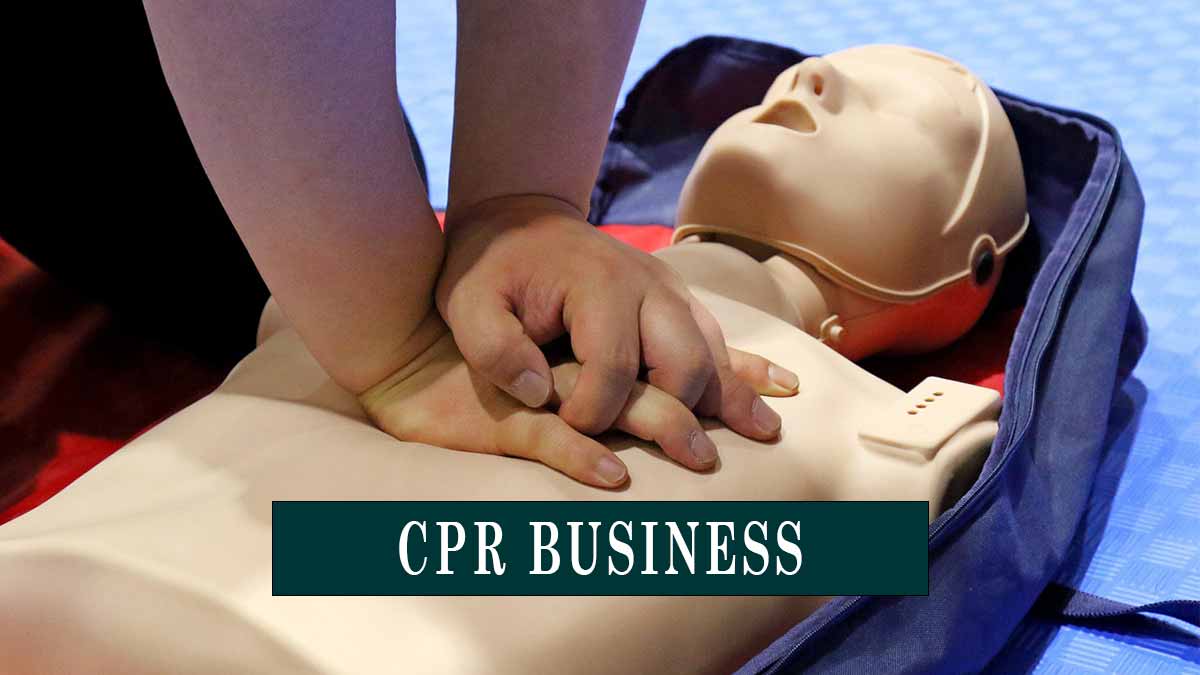Starting a CPR (Cardiopulmonary Resuscitation) business can be a fulfilling endeavor, as it involves teaching life-saving skills to individuals and organizations.
CPR is a crucial skill that can make a difference in emergency situations, and by starting your own CPR business, you can empower people with the knowledge and confidence to respond effectively during cardiac emergencies.
In this comprehensive guide, we will take you through the steps to successfully launch and operate your own CPR business.
Understanding the CPR Business
What is a CPR business?
A CPR business focuses on providing training and certification in Cardiopulmonary Resuscitation (CPR) and related life-saving skills. CPR instructors teach individuals and organizations how to respond effectively in emergencies such as cardiac arrest, choking, and drowning. CPR businesses play a critical role in promoting public safety and preparedness.
Why start a CPR business?
Starting a CPR business offers several compelling reasons:
- Life-saving impact: By teaching CPR and related skills, you empower individuals to save lives in critical situations.
- Steady demand: The need for CPR training is consistent, as individuals and organizations seek to ensure their preparedness for emergencies.
- Flexible business model: CPR businesses can offer a variety of courses and adapt to different markets, including schools, healthcare providers, businesses, and community groups.
- Personal fulfillment: Running a CPR business allows you to make a positive difference in your community while pursuing a fulfilling career.
10 Steps to Start Your CPR Business
1. Market Research and Planning
Before launching your CPR business, conducting thorough market research and strategic planning is essential.
Identifying your target audience
Determine your specific target audience for CPR training. This may include individuals, schools, childcare centers, healthcare professionals, businesses, or community organizations. Understanding your audience’s needs and preferences will guide your course offerings.
Analyzing competitors
Research existing CPR training providers in your area to understand their services, pricing, and reputation. Identify gaps in the market that you can address, and develop strategies to differentiate your business.
Creating a business plan
Develop a comprehensive business plan that outlines your goals, budget, marketing strategies, and growth projections. A well-structured plan will serve as your roadmap to success and guide your decision-making.
2. Legal and Regulatory Requirements
Ensuring compliance with legal and regulatory requirements is crucial for the operation of your CPR business.
Business structure and registration
Choose an appropriate business structure, such as a sole proprietorship, LLC, or corporation, and register your business with the necessary state and local authorities. Ensure that you have the required permits to operate as a training center.
Certification and accreditation
Become certified as a CPR instructor through accredited organizations such as the American Heart Association (AHA) or the American Red Cross. Your training center may also need accreditation to offer recognized certification courses.
Liability insurance
Invest in liability insurance to protect your business and instructors in case of accidents or injuries during training sessions. Verify the insurance requirements in your state and industry.
3. CPR Instructor Training and Certification
To effectively teach CPR, you need proper training and certification as an instructor.
Becoming a certified CPR instructor
Enroll in a certified CPR instructor course offered by organizations like the AHA or the American Red Cross. The course will equip you with the knowledge and skills to teach CPR and related courses.
Staying updated with guidelines
Stay informed about the latest CPR and AED guidelines, as they may evolve over time. Attend refresher courses and participate in ongoing training to maintain your expertise.
Gaining teaching experience
Gain teaching experience by assisting experienced instructors or teaching practice classes. Building your confidence and teaching skills is crucial before conducting your own classes.
4. Setting Up Your CPR Training Center
Choosing the right location and creating a conducive learning environment is essential for your CPR training center.
Choosing a suitable location
Select a location that is easily accessible to your target audience, whether it’s a dedicated training center or rented space. Ensure that the location complies with safety regulations and accessibility requirements.
Equipping your training center
Equip your training center with CPR mannequins, AED training devices, instructional materials, and first-aid supplies. Create a comfortable and safe learning environment for your students.
Creating a safe learning environment
Implement safety protocols, including proper ventilation, sanitation, and social distancing measures, especially during the ongoing COVID-19 pandemic. Prioritize the well-being of your students and instructors.
5. Curriculum Development and Course Offerings
Designing a comprehensive curriculum and offering a range of courses will attract a broader audience to your CPR business.
Designing comprehensive CPR courses
Develop CPR courses that cover a range of skills, including adult, child, and infant CPR, as well as AED training. Consider offering Basic Life Support (BLS) courses for healthcare professionals and advanced courses for more specialized training.
Incorporating AED training
Include AED training as a crucial component of your CPR courses. Automated External Defibrillators (AEDs) are increasingly available in public places, and teaching people how to use them can save lives.
Customizing courses for specific audiences
Tailor your courses to specific audiences, such as schools, daycare centers, businesses, or healthcare providers. Customize the content to address the unique needs and challenges of each group.
6. Pricing and Marketing Strategies
Effective pricing and marketing strategies are essential to attracting and retaining clients.
Setting competitive prices
Research the pricing strategies of your competitors and set competitive yet profitable prices for your CPR courses. Consider offering package deals or discounts for group bookings.
Marketing your CPR business
Develop a marketing plan that includes online and offline strategies. Use flyers, brochures, and online advertising to promote your courses.
Highlight the importance of CPR training and its potential to save lives.
Online presence and social media
Create a professional website for your CPR business where potential clients can learn about your courses, instructors, and testimonials.
Utilize social media platforms to engage with your audience, share educational content, and promote upcoming classes.
7. Operational Management
Efficient operational management is crucial for delivering quality CPR training and ensuring student satisfaction.
Managing class schedules
Implement a class scheduling system that allows students to register for courses easily. Ensure that your schedule accommodates different time preferences, including evenings and weekends.
Maintaining training materials
Regularly inspect and update your training materials, including mannequins, AED devices, and instructional materials. Ensure that all equipment is in good working condition for each class.
Ensuring student engagement and success
Foster a positive learning environment by encouraging student participation and engagement during training sessions.
Provide feedback and guidance to help students improve their skills and confidence.
8. Building Partnerships and Networking
Building partnerships and networking within the CPR and healthcare community can help grow your business.
Partnering with schools and businesses
Collaborate with local schools, daycare centers, and businesses to provide CPR training for staff and students. Offer group discounts and tailored programs to meet their specific needs.
Collaborating with healthcare providers
Establish partnerships with healthcare providers, hospitals, and medical facilities to offer BLS and advanced life support training to their staff. Healthcare professionals often require regular certification updates.
Attending CPR industry events
Participate in CPR industry events, conferences, and workshops to stay updated with the latest trends and network with professionals. These events can provide valuable insights and opportunities for growth.
9. Scaling Your CPR Business
As your CPR business grows, consider opportunities for expansion and scaling.
Expanding your course offerings
Diversify your course offerings by including related training, such as First Aid, Pediatric Advanced Life Support (PALS), or Neonatal Resuscitation Program (NRP). Expanding your offerings can attract a broader clientele.
Hiring additional instructors
As the demand for your CPR courses increases, consider hiring additional certified instructors to accommodate more students and expand your class schedule.
Expanding to new locations
Explore opportunities to open additional training centers in different geographic locations. Expanding your reach can tap into new markets and increase your business’s visibility.
10. Quality Assurance and Student Satisfaction
Maintaining quality training and ensuring student satisfaction is vital to the long-term success of your CPR business.
Monitoring instructor performance
Regularly evaluate your instructors’ performance to ensure that they are providing high-quality training. Conduct audits and assessments to identify areas for improvement.
Collecting student feedback
Solicit feedback from students after each course to gather insights into their learning experience. Use this feedback to make necessary adjustments and improvements.
Continuous improvement
Stay committed to continuous improvement by staying updated with the latest CPR guidelines, teaching techniques, and technology. Strive to provide the best possible training for your students.
Read Also: How to Start a Dump Truck Business – A Complete Guide
Conclusion
Starting a CPR business allows you to make a meaningful impact on your community by equipping individuals and organizations with life-saving skills. By following the steps outlined in this comprehensive guide, you can establish a successful CPR business that empowers people to respond confidently and effectively during emergencies.
[Frequently Asked Questions] FAQs
Here are some commonly asked questions about starting a CPR business:
How much does it cost to start a CPR Business?
Starting a CPR business can cost anywhere from a few thousand to several thousand dollars, depending on factors like certification fees, equipment, legal requirements, and marketing expenses.
Costs include instructor certification, liability insurance, training materials, a physical training center if applicable, and ongoing operational expenses.
A well-structured business plan is crucial for budgeting and financial planning.
Is a CPR Business Profitable?
A CPR business can be profitable, as it serves a critical need for CPR and life-saving training. Profitability depends on factors like pricing, demand in your area, and effective marketing.
Offering quality courses, targeting various customer groups, and maintaining a strong online presence can enhance profitability over time.
Do I need to have a medical background to start a CPR business?
While a medical background can be beneficial, it is not a strict requirement. Becoming a certified CPR instructor and regularly updating your knowledge is essential for teaching CPR effectively.
How long does it take to become a certified CPR instructor?
The duration varies depending on the certification program and your prior knowledge. Generally, it takes several days to complete the required training and certification process.
What types of organizations can benefit from CPR training?
Organizations such as schools, childcare centers, businesses, healthcare facilities, community groups, and sports teams can all benefit from CPR training to ensure the safety of their members and staff.
Is liability insurance necessary for a CPR business?
Yes, liability insurance is essential to protect your business and instructors in case of accidents or injuries during training sessions. Verify the insurance requirements in your state and industry.
How can I stay updated with the latest CPR guidelines and techniques?
To stay updated, regularly attend refresher courses, workshops, and seminars offered by reputable CPR organizations. Additionally, monitor updates from organizations like the American Heart Association (AHA) or the American Red Cross for guideline changes.





Hey people!!!!!
Good mood and good luck to everyone!!!!!